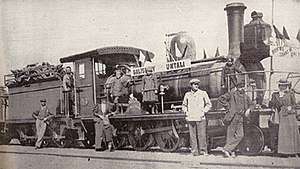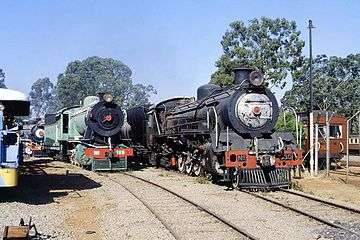National Railways of Zimbabwe
The National Railways of Zimbabwe (NRZ) is the parastatal railway of Zimbabwe (formerly Rhodesia). The Zimbabwean railway system was largely constructed during the time of British colonial rule and was called Rhodesia Railways (RR) until 1980. Segments of its systems were intended to be part of the Cape to Cairo Railway.
| Parastatal | |
| Industry | Rail transport |
| Predecessor | Rhodesia Railways (RR) |
| Founded | 1980 |
| Headquarters | , |
Key people | Lewis Mukwada, general manager |
| Products | Rail transport, Cargo transport, Services |
| Owner | Republic of Zimbabwe (100%) |
Number of employees | 7,543 (2008)[1] |
| Website | www.nrz.co.zw |
Rhodesia Railways

In the colonial era, Rhodesia Railways was the state railway operator in both Southern Rhodesia (now Zimbabwe) and Northern Rhodesia (now Zambia). Although Zambia gained independence in 1964, it was not until 1967 that Rhodesia Railways surrendered the 1,300 km (810 miles) of route and 80–90 locomotives to Zambia Railways.[2]
Rhodesia Railways was a heavy user of the Garratt locomotive. In June 1976, 100 of its 109 steam locomotives were Garratts. For operational purposes, Rhodesia Railways was divided into two areas: those lines north-east of Gwelo (now Gweru) fell into the Eastern Area, with all other lines in the Southern Area.[3]
| Bulawayo | Gwelo | Total | |
|---|---|---|---|
| 12th class (4-8-2) | 5 | 1 | 6 |
| 14A class (2-6-2+2-6-2) | 7 | 6 | 13 |
| 15th class (4-6-4+4-6-4) | 52 | 0 | 52 |
| 16A class (2-8-2+2-8-2) | 8 | 9 | 17 |
| 19th class (4-8-2) | 3 | 0 | 3 |
| 20th class (4-8-2+2-8-4) | 18 | 0 | 18 |
| Total | 93 | 16 | 109 |
Operations

NRZ operates about 4,225 km (2,600 miles) of railway lines, all of 3 ft 6 in (1,067 mm) providing passenger and freight services. The gauge is standard for all of southern Africa. NRZ has an important transit function in the southern part of Africa and is well linked with neighboring countries: toward the north, at Victoria Falls the system links to the Zambia Railways, crossing the Victoria Falls Bridge. Toward the Indian ocean the system links to the Beira Railroad Corporation in Mozambique. A second line toward Mozambique reaches Maputo. To the west, a connecting line link ups to Botswana Railways to reach South Africa, eventually reaching Durban and Cape Town. A direct line to South Africa from Bulawayo was opened in 1999 by the Beitbridge Bulawayo Railway. The 313 km (194-mile) Gweru-Harare section is electrified at 25 kV AC. The section was extensively vandalised and the copper cables stolen. The line is no longer functional.
Steam
Steam locomotives are still used in Zimbabwe; they have proven so popular with tourists that there are plans to refurbish several more steam locomotives.[4] However, funding is constrained, and diesel-hauled freight transport is a higher priority.[5]
Crisis
The NRZ has also suffered from the general decline of the country's economy. Neglect of maintenance, lacking spare parts and overdue replacement of equipment have led to a situation were only part of the railway net is in good condition and equipment problems have led to reduced service. Steam locomotives have been reintroduced since 2004 as coal is in relatively good supply, while diesel must be imported and electricity shortages are common. Further, the company is seriously indebted, making it impossible to solve this situation without external help.[6] Goods transport has declined, from 18 million tonnes in 1998 to 2 million tonnes in 2010.[7]
Recapitalisation
More than 80 companies attended a compulsory pre-bid conference for the Framework to Recapitalise the National Railways of Zimbabwe held on 30 May 2017 in response to a Request for Proposals floated by the organisation in national, regional and international newspapers.
Fifty of the companies at the pre-bid conference held in Bulawayo were from Zimbabwe, 18 from South Africa and eight from China. The rest were from the United Kingdom, Malaysia, India, Belgium and Dubai.
The Government of Zimbabwe in April approved the Framework to Recapitalise the National Railways of Zimbabwe at a cost of more than US$400 million after the NRZ engaged chartered accountancy firm, Deloitte and Touche as its Transaction Advisor to assist in raising money to recapitalise its operations.
After the pre-bid conference, a voluntary due diligence inspection of NRZ assets was organised for interested investors from 6 to 9 June. Over 10 companies took up the offer and spent four days visiting NRZ facilities.
The potential investors visited NRZ installations in Bulawayo, Sawmills, Dete and Gweru to understand more about the organisation's operations before submitting their tender documents. Senior NRZ officials answered questions and queries from the potential investors.
The due diligence inspection started with a visit to the hub of NRZ maintenance work, the Bulawayo Mechanical Workshops, which boasts the largest factory space in Zimbabwe. This is where locomotives and wagons are repaired and refurbished.
The potential investors were also taken on a tour of the Central Mechanical Workshops, Mpopoma Diesel Running Maintenance depots and Mpopoma Repair Siding. Also visited were the Central Maintenance Vehicles Workshop, the Bridge and Structural Workshop and the Materials Yard. These facilities are in Bulawayo, the headquarters of the NRZ.
The investors were taken on a special train to Dete, with stops at Sawmills to see areas which they may be interested in investing in, including a re-railing (laying of new rail) project on a section of the north corridor rail and the Centralised Train Control System at Sawmills. They also assessed assets at Dabuka Marshalling Yards near Gweru where they inspected the track condition and the electrified section.
The tendering process closed on 4 July at 10 am. Six companies successfully submitted their bids to the State Procurement Board (SPB). The six companies are from China, Malaysia, South Africa, Switzerland and Zimbabwe. They are Sino Hydro, China Civil Engineering Construction Corporation, SMH Rail, Transnet Freight Rail, Diaspora Infrastructure Development Group (DGIG) which is a consortium between Transnet and Zimbabweans in South Africa, Crowe Horwath and Croyeaux Limited.
The next step is the adjudication process of the six bidders, where the best bidder as per the proposals will be selected and chosen for the project.
The recapitalisation of the NRZ was initiated to restore the organisation's operational capacity and return it to profitability. The NRZ system, at one time, had the capacity to carry over 18 million tonnes of freight annually but a general decline in the economy and the organisation's reduced operational capacity have seen freight volumes fall to 12.4 million tonnes in 1998 and 2.7 million tonnes in 2016.
The NRZ has a fleet of 168 locomotives, with 60 locos in service and more than 7,000 wagons of which 3,512 are in use.
The recapitalisation project will involve the rehabilitation and renewal of plant, equipment, rolling stock, track, signalling and telecommunication infrastructure and the supporting information technology systems.
Major accidents
- On 27 August 2006 more than 60 people were killed in a head-on collision between a passenger train and a freight train 30 kilometres (19 mi) south of Victoria Falls.[8]
- On 3 June 2006 five fatalities occurred in the Ngungumbane rail crash.
- On 1 February 2003 40 people died in the Dete train crash.[9]
Major lines and stations
| Line | Stations | Notes |
|---|---|---|
| Victoria Falls – Bulawayo | Link from Victoria Falls to Zambia Railways, Zambia.
The charge is currently $60 for the sleper class, $50 for the standard class and $40 for the economy class.[10] | |
| Beira–Bulawayo railway |
Bulawayo – Harare section Harare – Mutare section |
Link from Mutare to Beira Railroad Corporation, Mozambique. The Harare-Mutare route is currently the busiest route. The sleeper class is currently $40, whilst the standard class is $30 and the economy class $25.[10] Link from Chicualacuala to Maputo, Mozambique The charge is currently $60 for the sleper class, $50 for the standard class and $40 for the economy class.[10] |
| Bulawayo – Francistown |
|
Part of the line is in Botswana
Connects further to Mahikeng, South Africa In 1911 Rhodesia Railways was granted a special agreement to preserve its rights of access under the Tati Concessions Land Act, which formally annexed a former territory of Matabeleland, an area including Francistown, to the Bechuanaland Protectorate (modern Botswana). |
| Harare – Shamva/Kildonan/Zawi | ||
| Somabhula-Sango |
|
Link from Chicualacuala to Maputo, Mozambique Link from Harare and Bulawayo, via Beira–Bulawayo railway |
| Beitbridge Bulawayo Railway (privately owned) |
Connects to Beitbridge, South Africa.
The privately owned Beitbridge Bulawayo Railway (BBR) provides a direct rail link to South Africa. This railway was opened in 1999 and will become part of the NRZ after 30 years. |
Museum

The Zimbabwe National Railways Museum is in Bulawayo; it has a selection of locomotives, railway carriages and other interesting things. One of the exhibits is a Rhodesia Railways class DE2 diesel locomotive.
Well known employees (past and present)
- Former Vice President Joshua Nkomo worked there as a social worker in 1948.
- Sir Roy Welensky, the last Prime Minister of the Federation of Rhodesia and Nyasaland, worked as an engineer for Rhodesia Railways before entering politics.
- Frank Edward Hough, Esq., O.B.E., was Chief Mechanical Engineer for Rhodesia Railways, from which he was appointed a C.B.E. in 1953.
See also
References
- "Railway Union Reports (by: International Transport Workers' Federation):The restructuring and privatisation of the National Railways of Zimbabwe (NRZ) . Issue 6 - July 2008". Archived from the original on 22 July 2011. Retrieved 7 December 2010.
- Turk 1976, p. 76
- Turk 1976, pp. 76–77
- "REFURBISHING FOR MORE ZIM STEAM LOCOS". Railways Africa. Retrieved 9 November 2010.
- "BULAWAYO STEAM". Railways Africa. 12 December 2010. Retrieved 12 December 2010.
- "Africa news.com: Zimbabwean trains held in China over debt. 6 December 2010". Archived from the original on 10 December 2010. Retrieved 7 December 2010.
- "NRZ FREIGHT STATS PLUMMET". Railways Africa. Retrieved 19 February 2011.
- "Victoria Falls train crash claims five lives". ZimObserverNews. 28 August 2006. Retrieved 18 September 2006.
- "BBC NEWS | World | Africa | 40 die in Zimbabwe train crash". news.bbc.co.uk. Retrieved 6 September 2017.
- Herald, The. "High bus fares trigger demand for train service". The Herald. Retrieved 2 October 2019.
Sources
- Durrant, A E (1997). The Smoke that Thunders. Harare: African Pub. Group. ISBN 1779011342.
- Hamer, Edward D (1983). Steam locomotives of Rhodesia Railways: the story of steam 1892-1979. Malmö: Stenvalls. ISBN 9172660775.
- Hamer, Edward D (2001). Locomotives of Zimbabwe and Botswana. Malmö: Stenvalls. ISBN 9172661526.
- Robinson, Neil (2009). World Rail Atlas and Historical Summary. Volume 7: North, East and Central Africa. Barnsley, UK: World Rail Atlas Ltd. ISBN 978-954-92184-3-5.
- Turk, Andrew (February 1976). "Garratts Galore". Railway World. Shepperton, Surrey: Ian Allan: 76–78.CS1 maint: ref=harv (link)
External links
| Wikimedia Commons has media related to Rail transport in Zimbabwe. |
- Official Website
- How to Travel Info
- About the Railway Museum
- Winchester, Clarence, ed. (1936), "Progress in Rhodesia", Railway Wonders of the World, pp. 867–874 illustrated account of the development of the railways of Rhodesia
- Steam Railway Photographs - Zimbabwe